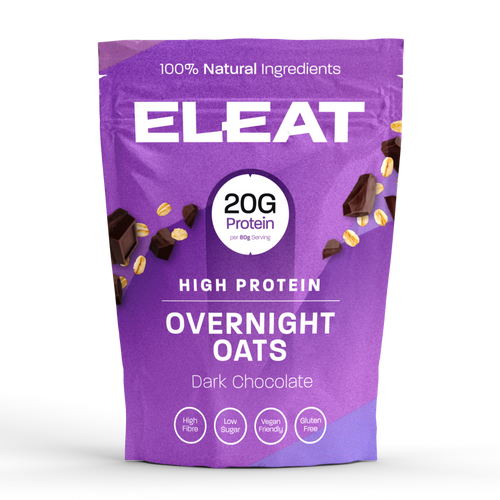In this article:
Protein is a fundamental nutrient that plays a vital role in muscle growth, recovery, and overall health. It helps repair tissues, supports immune function, and is essential for hormone and enzyme production. Whether you’re an athlete looking to maximise muscle gains or simply aiming for better health, getting enough protein is key.
However, a long-standing debate exists about how much protein the body can actually process in one sitting. Many believe that consuming more than 20-30 grams of protein per meal is pointless because the body supposedly can’t absorb or use more than that at once. But is that really the case?
Is there truly a limit to how much protein your body can absorb at one time, or is it just a myth? Let’s break down the science behind protein digestion and find out the truth.
Protein Digestion and Absorption
When you eat protein, the body works through a multi-step process to break it down and use it effectively. The journey begins in the stomach, where gastric juices containing hydrochloric acid and enzymes like pepsin start to unravel the protein’s complex structure. This action turns the protein into smaller chains called peptides.
From there, the partially digested protein moves into the small intestine, where most of the digestion takes place. Here, enzymes like trypsin and chymotrypsin break down the peptides into even smaller pieces—amino acids, the building blocks of protein. These amino acids are then absorbed through the lining of the small intestine and enter the bloodstream, where they are transported to various parts of the body for muscle repair, growth, and other vital functions.
The rate at which protein is absorbed varies depending on the type of protein consumed. For instance, whey protein, a fast-digesting option, enters the bloodstream relatively quickly, often within about 30-60 minutes after ingestion. This makes it ideal for quick muscle recovery post-workout. On the other hand, casein protein, a slow-digesting protein found in dairy products, is absorbed more gradually, providing a steady release of amino acids over several hours
The Myth of a ‘Protein Ceiling’
A common belief in the fitness and nutrition world is that the body can only absorb 20-30 grams of protein per meal, with anything beyond that going to waste. However, this is a misunderstanding of how protein metabolism actually works.
Absorption vs. Utilisation
The body absorbs all the protein you consume—there’s no strict limit where excess protein suddenly becomes useless. Once the protein is broken down into amino acids in the digestive system, those amino acids enter the bloodstream and are transported to various tissues where they can be used for multiple purposes.
However, just because protein is absorbed doesn’t mean it’s all used for muscle building at once. Muscle protein synthesis (MPS)—the process of repairing and building muscle—does have a threshold, typically maxing out at around 20-40 grams per meal depending on factors like body size, activity level, and training status. Any additional protein doesn’t go to waste, though—it can still be used for other bodily functions, such as:
Supporting immune function
Producing enzymes and hormones
Providing energy if needed (via gluconeogenesis)
Where Did the 20-30g Myth Come From?
The idea of a protein ceiling likely stems from studies on MPS, which found that consuming more than ~20-30g of protein per meal didn’t further increase muscle-building benefits. However, this doesn’t mean that extra protein is wasted—it just means that excess protein in that meal might be used for other functions or processed over a longer period.
Bottom Line
Your body does not have a hard limit on how much protein it can absorb, but there is a practical limit to how much protein contributes to muscle growth in a single meal. Instead of fixating on a strict per-meal protein cap, it’s more important to focus on total daily protein intake and spreading protein consumption throughout the day for optimal muscle recovery and overall health.
Factors That Influence Protein Utilisation
While the body absorbs all protein consumed, how efficiently it utilises that protein depends on several factors. Understanding these variables can help optimise protein intake for muscle growth, recovery, and overall health.
Meal Timing & Distribution
Rather than consuming all daily protein in one or two large meals, research suggests that spreading protein intake evenly across multiple meals enhances muscle protein synthesis (MPS). Studies indicate that consuming 20-40g of protein per meal spaced every 3-4 hours maximises muscle-building potential. This approach, known as protein pacing, ensures a steady supply of amino acids for muscle repair and growth throughout the day.
Muscle Mass & Activity Level
Individuals with greater muscle mass or those engaging in intense physical activity (such as weight training or endurance sports) have higher protein needs and may utilise protein more efficiently. Their bodies can process and distribute more amino acids toward muscle repair and recovery, making higher per-meal protein intakes (closer to 40g) beneficial. In contrast, sedentary individuals may not require as much protein per meal for muscle maintenance.
Type of Protein
Not all proteins digest at the same rate, which impacts how quickly amino acids become available for MPS:
Fast-Digesting Proteins (e.g., Whey Protein): Absorbed rapidly (within 30-60 minutes), making them ideal for post-workout recovery when quick amino acid delivery is needed.
Slow-Digesting Proteins (e.g., Casein Protein): Provide a steady release of amino acids over several hours, making them useful for prolonged periods without food, such as before sleep.
Plant-Based Proteins: Often digest slower and may be lower in essential amino acids, but combining sources (e.g., rice and pea protein) can create a complete amino acid profile.
Metabolic Rate & Gut Health
Individual differences in metabolic rate, digestion, and gut health can affect how well protein is utilised. A healthy digestive system ensures efficient breakdown and absorption of amino acids, while gut issues (such as poor enzyme function or imbalanced gut bacteria) may reduce protein efficiency. Additionally, people with higher metabolic rates (such as those who are highly active or have more muscle mass) tend to process and use protein more effectively.
Key Takeaway
There is no one-size-fits-all approach to protein utilisation. Factors like meal timing, muscle mass, protein type, and individual metabolism all play a role in how protein is processed. To optimise protein intake, aim for consistent, well-distributed meals with high-quality protein sources tailored to your activity level and goals.
How Much Protein Can The Body Process At Any Time?
One of the most debated topics in nutrition is how much protein the body can effectively use per meal. While muscle protein synthesis (MPS) appears to max out at around 20-40 grams per meal, that doesn’t mean excess protein is wasted. The body still absorbs all protein consumed, but any amount beyond what’s needed for muscle building may be used for other functions, such as:
Tissue repair and enzyme production
Supporting immune function
Energy production (via gluconeogenesis, if necessary)
Protein Pacing: The Key to Maximising Absorption
Instead of consuming large amounts of protein in one sitting, spreading protein intake evenly throughout the day—a strategy known as protein pacing—has been shown to optimize MPS and muscle recovery. Research suggests that eating 20-40g of protein per meal spaced every 3-4 hours, is ideal for maximizing muscle growth and overall protein utilization.
For example, someone consuming 150g of protein daily could distribute their intake as follows:
✅ Breakfast: 30g
✅ Lunch: 40g
✅ Post-Workout Meal: 40g
✅ Dinner: 40g
How Much Protein Do You Need?
Your optimal per-meal protein intake depends on body weight, activity level, and fitness goals. General recommendations based on current research are:
Sedentary individuals: 0.8g per kg (0.36g per lb) of body weight per day
Active individuals & general fitness enthusiasts: 1.2-2.0g per kg (0.54-0.91g per lb)
Strength training & muscle gain: 1.6-2.4g per kg (0.73-1.1g per lb)
Fat loss (while preserving muscle): 2.0-2.5g per kg (0.91-1.14g per lb)
For a 75kg (165lb) active individual aiming for muscle growth, this translates to 120-165g of protein daily, divided into 3-5 meals of 25-40g each for optimal utilisation.
Conclusion
The idea that the body can only process a limited amount of protein per meal is a myth. While muscle protein synthesis (MPS) peaks at 20-40g per meal, excess protein is still absorbed and used for tissue repair, immune function, and energy when needed.
Rather than fixating on per-meal limits, focus on meeting your total daily protein needs and spreading intake evenly across 3-5 meals to optimize MPS. Prioritising high-quality protein sources and consistent intake is key to muscle growth, recovery, and overall health. Instead of worrying about a protein ceiling, aim for a balanced, protein-rich diet to achieve long-term success.















